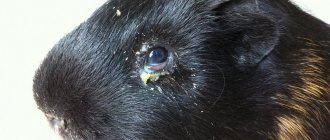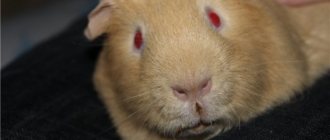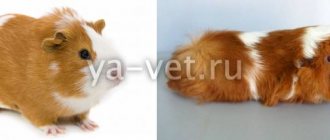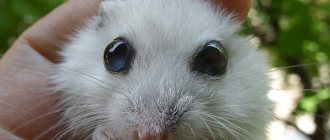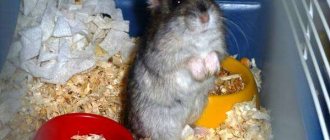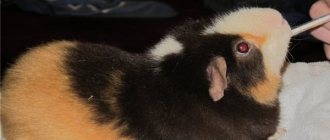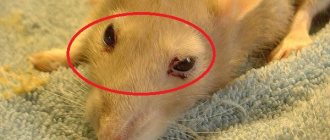If your guinea pig's eyes suddenly start to water, this can have various causes, from injury to disease. Eye diseases in guinea pigs are quite common. There are many reasons for their development in this animal species:
- bacterial infections;
- injuries (injections with hay, scratches received during the division of territory);
- metabolic disorders (obesity, excess or deficiency of vitamins);
- as a secondary disease, for example, against the background of diabetes mellitus;
- biological old age of the animal.
Symptoms of diseases
If you rarely pick up your pig or approach its cage only once every 2-3 days, you may miss the onset of eye disease. In other cases, owners immediately notice that their pet has something “wrong” with its eyes:
- they become watery and/or sour;
- a guinea pig has a white spot inside its eye;
- the pupil becomes cloudy from the inside or a film forms on its outer side;
- eyelids turn red or droop;
- the eyeball twitches or protrudes, turns unnaturally.
In this case, the veterinarian can diagnose keratitis, conjunctivitis, keratoconjunctivitis, cataracts, nystagmus, prolapse, entropion, problems with the Harderian glands, anophthalmia or microphthalmia in the animal. Depending on the diagnosis, treatment will be prescribed. It is not recommended to treat your guinea pig's eyes on your own.
Changes in the lens and cornea
With advanced keratoconjunctivitis, if treatment for an infectious eye disease is ignored, the cornea of the seagull becomes cloudy, which is manifested by the appearance of a cataract, and dangerous loss of vision. The problem is eliminated in the clinic surgically.
When metabolism changes or there is a lack of vitamins, the lens does not refract light and does not direct rays to the retina. When the eyes are damaged by cataracts, the animal begins to see worse. Treatment slows the onset of blindness.
For glaucoma, which occurs when the cells lining the optic nerve die in a pet:
- the cornea swells;
- the eye swells;
- the pupil does not react to light;
- Tormented by lacrimation.
At the beginning of the appearance of deviations, drugs are instilled to help maintain intraocular pressure at a normal level.
When the conjunctival sac protrudes, which passes to the rodent from its parents, plastic surgery is performed using a laser.
Eye treatment
So, taking a guinea pig with problem eyes to the vet is the first step. The animal must be professionally examined. Then he will be prescribed competent treatment. The owner must instill the prescribed medications (if drops) or apply (if ointment) to the animal regularly, in accordance with the doctor’s prescription. And make sure that the medicine is evenly distributed over the cornea. In addition, discharge from the eyes can be removed with cotton pads soaked in boiled water, chamomile infusion or saline solution.
Causes
A complex of immunological reactions is most often caused by:
- Food;
- medicines;
- volatile allergens (pollen, chemicals, etc.);
- insect bites.
The disease may be non-allergic in nature. In this case, in addition to allergens, it is caused by: stress, infectious diseases, external factors (for example, hypothermia), intoxication of the body. Source: A. V. Lyapunov. Urticaria and Quincke's edema in children // Children's allergology. Ed. A.A. Baranova, I.I. Balabolkina. M.: GeotarMedia, 2006; 486-497.
Medicine also knows quite a lot of cases where the reason for such a reaction of the body has not been established.
Unusual Facts About Guinea Pig Eye Diseases
Most often, eye diseases affect simple, mongrel animals. In decorative guinea pigs bred for participation in exhibitions, such problems are much less common.
However, there are eye diseases that are characteristic only of certain breeds of pigs:
- Ulcers on the mucous membrane of the eyes are found only in young Texel and Rex animals, since the hard hairs of the fur scratch their eyes.
- Only selfies have fatty eyes.
- Abbesinians are more susceptible to cataracts than other breeds.
A guinea pig owner (especially a novice hobbyist) should be aware that excess vitamin C in his pet's diet can lead to the formation of a bone in the eyes between the sclera and the pupil. And sometimes such a bone is visible even without ophthalmic equipment. True, there is no need to be particularly alarmed, because this neoplasm does not affect the animal’s quality of vision in any way, but the animals’ nutrition should be adjusted taking this factor into account.
Quincke's edema in children
- Symptoms of the disease
- How does Quincke's edema begin in a child?
- Causes
- First aid
- Treatment of Quincke's edema in children
Attacks most often occur in children with urticaria. Pediatricians associate swelling with hay fever, bronchial asthma, and atopic dermatitis.
Important! This is a dangerous condition, which in a quarter of cases provokes swelling of the larynx.
Quincke's edema occurs in newborns and older children. Its nature is most often allergic, but this phenomenon can be hereditary and also have no clear origin. Source: I.I. Balabolkin. Urticaria and angioedema in children // Pediatrics, 2009, v. 87, no. 2
The prognosis is usually favorable; it becomes poor with frequent relapses and associated swelling of the internal organs and larynx. The consequences may be anaphylactic shock, bronchospasm.
For prevention, in some cases vaccination is carried out. Its necessity is determined individually. Clinical recommendations for parents: provide the child with a low-allergen diet, take antihistamines at intervals recommended by the doctor, minimal or no contact with the allergen.
Pasteurellosis
You can understand that a guinea pig has fallen ill with pasteurellosis by several signs:
- mucus around nostrils;
- runny nose;
- the animal sneezes often.
As a result of such sensations, the pig develops severe irritation in the affected area. The rodent constantly scratches its nose with its paws, and thus aggravates the course of the disease. First, mucous and then purulent white or grayish discharge flows from the nose. Breathing becomes difficult. You can hear the animal snoring or snoring. At an advanced stage, purulent wounds appear on the skin.
The causative agent of this disease is pathogenic microbes. At the initial stage, it is quite easy to destroy the pathogen. For these purposes, the animal is given disinfectants.
If the causative agent of pasteurellosis enters the blood through wounds, the blood system becomes infected. Infection is accompanied by fever, weakness, diarrhea, and in rare cases, convulsions. It is almost impossible to cure an animal whose blood is infected with the causative agent of pasteurellosis. Therefore, it is simply destroyed.
For animals that are suspected of being infected with this infection, the veterinarian prescribes sulfa drugs and antibiotics.
Parasites
Often, the process of hair loss can be caused by several factors simultaneously. For example, a parasitic disease is the main one, and an allergy or fungus is an auxiliary one.
To cure such a disease, it is necessary to conduct a competent diagnosis from a veterinarian. To do this, special laboratory equipment is used to examine the skin and fur for the presence of a particular parasite.
Lice eaters, fleas and ticks are the main parasites that infect the skin of guinea pigs at home.
Trixacarosis
The development of this disease is caused by microscopic mites that parasitize in the thickness of the skin. Infection with parasites occurs through direct contact with sick individuals. Such animals constantly itch, tearing the skin until there are wounds and blood. As a result, their hair begins to fall out. Diagnosis is carried out in a veterinary clinic. A skin scraping is taken from the animal and checked for the presence of parasites. It is worth remembering that such subcutaneous pests that are transmitted to humans are very dangerous.
Sarcoptic mange
In this case, as in the previous one, the causative agent of the disease is a microscopic mite. Only this parasite lives on the surface of the skin. Infection occurs through contact with sick pigs, as well as through bedding or food. In places where scratching occurs, wounds and a grayish crust appear, then the process of hair loss occurs. Initially, the paws and muzzle are affected, then the mites begin to multiply and infect the skin throughout the body. These are very dangerous parasites, and if timely measures are not taken, the animal may simply die.
Demodicosis
This disease is caused by microscopic mites living under the skin. It manifests itself through severe itching. In places where scratching occurs, the skin becomes rough, peels and goes bald. At an advanced stage, ulcers and papules with grayish pus appear in places where the lesion is localized. In most cases, the area of the paws and head is affected. Healthy individuals become infected through contact with sick pigs. For humans, this is a dangerous sore, since ticks transmitted through contact begin to infect human skin.
lice eaters
These are microscopic insects that resemble human lice in appearance. They infect the scalp, gnawing every hair at the very root. The affected areas become bald. You can identify such parasites using a magnifying glass. Locations: perineum and croup area.
Treatment of a guinea pig for the parasites presented above is carried out using a special drug - Frontline. Sick animals are moved to a separate cage. They clean and disinfect the cage more often than usual in order to prevent secondary infection.
Preventing vision problems in your pet
To keep your guinea pig healthy and with good eyesight, you need to consider his lifestyle and follow some simple guidelines:
- Keep the males separate as they each need to have their own territory, otherwise they will fight and chase each other around the cage (leading to injury and biting).
- Do not put a lot of dry branches or thick straw in the cage so that he can move freely without the risk of injury.
- The owner should periodically check the eyes and clean the fur around them if there is any discharge.
- For the treatment and care of the eyes, only veterinary drugs suitable for rodents should be used (only Levomycetin eye drops from the first aid kit are considered suitable).
- The cage should be placed in a bright and cool place (pigs need daylight).
- When a guinea pig reaches old age (after 5 years), it needs periodic examinations by a veterinarian to identify possible eye problems and begin timely treatment.
Ways to see a pig in the dark
Like other rodents, guinea pigs move well and see in dark rooms. Although they are not actually helpless at night and can perform basic activities, rodent vision is still considered daytime. For this reason, it is ideal to place the cage in a well-lit area, but away from direct sunlight.
Experiments have been conducted to prove the negative effects of darkness on animals. Degradation, disease and various types of mutations occur. It has been observed that in the process of survival, animals navigate better through hearing and smell than through vision.
The most important senses for all rodents are hearing and taste. For this reason, guinea pigs often taste everything, even inedible objects (paper, sawdust, wire, fabric). When searching for food, guinea pigs are guided by the color, smell and taste of food and can remember what they ate (bitter, sweet and salty).
Sweet foods are always preferable. Rodent owners should know that honey and molasses are among the favorite treats of these animals.
The pig can also see in the dark, but much worse than during the day. Rodents are less active at night, but daylight is extremely important for them.
First aid
call an ambulance immediately . Doctors may decide on emergency hospitalization if the patient has difficulty breathing, a swollen tongue, or symptoms indicating intestinal damage.
What to do before the doctors arrive?
First aid, which should be provided at the first symptoms of angioedema in children, involves clearing the airways, checking breathing intensity, heart rate, and blood pressure. Sometimes it is necessary to perform cardiopulmonary resuscitation, so after the first case, parents are recommended to take first aid courses. At the final stage, medications should be administered to the child.
First aid equipment includes:
- glucocorticosteroids (“Prednisolone”, “Dexamethasone”);
- antihistamines;
- adrenalin.
Sequence of administration: adrenaline, then glucocorticosteroid, then antihistamine. If the reaction is moderate, then adrenaline is excluded.
| Adrenalin | It is injected intramuscularly into the thigh (middle third outside) at the rate of 0.01 mg for each kg of the child’s weight. If there is no effect, then the injections are repeated every 15 minutes. |
| Glucocorticosteroids | Injected intramuscularly into the buttock or intravenously. You can pour the medicine from the ampoule under the tongue - this way the effect will come faster. The dosage of Prednisolone is from 60 to 150 mg, Dexamethasone is from 8 to 32 mg. |
| Antihistamine | Intramuscular injection is preferable. It is possible to take a pill, but the effect will come later. The dosage depends on the medicine. For example, “Loratadine” – 10 mg, “Cetrizine” – 20 mg. |
Important! In case of swelling of the larynx, a tracheostomy is performed urgently.
